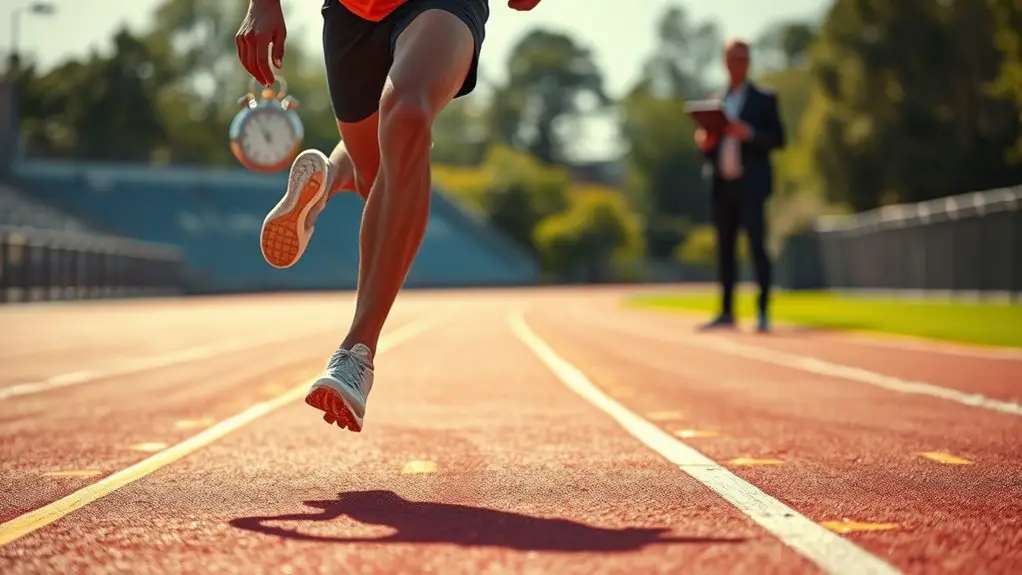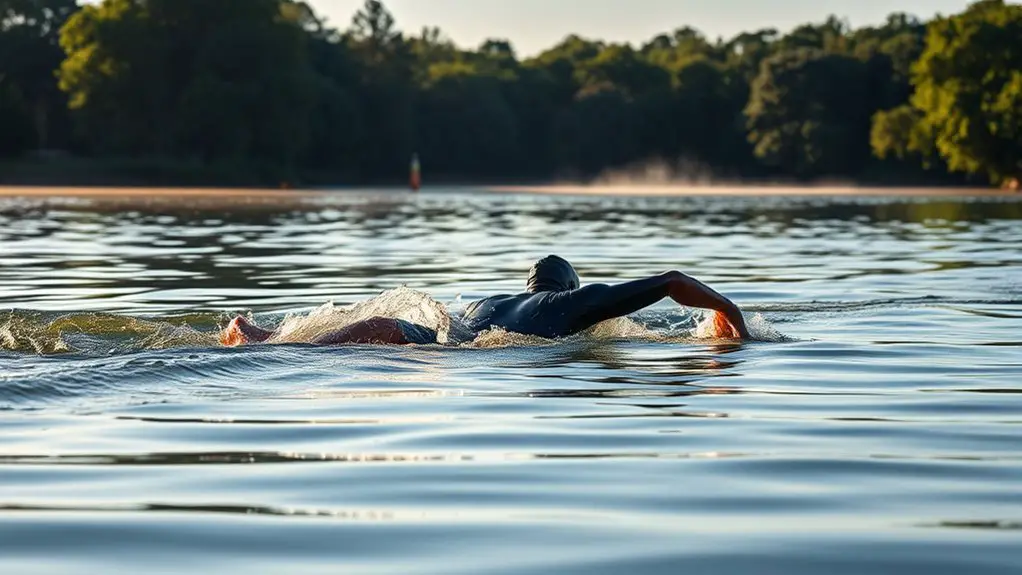To increase your foot speed as a sprinter, focus on strength training and plyometric drills. Incorporate exercises like squats and box jumps to build power and explosiveness. Refining your technique is vital—maintain proper body position and strike mid-foot for quicker turnover. Don't forget agility work and flexibility training for overall performance. Finally, prioritize nutrition and recovery strategies to keep your body fueled and ready. Stick around to uncover more tips and insights for improving your speed.
Understanding Foot Speed and Its Importance
Foot speed is essential for sprinters, as it directly impacts their performance on the track. When you're flying down the straightaway, every millisecond counts, and your foot speed can mean the difference between victory and defeat. Think of it as your body's natural freedom to move swiftly and efficiently. The quicker your feet can hit the ground and push off, the faster you'll propel yourself forward. Understanding foot speed isn't just about raw speed; it's about rhythm, coordination, and timing. By honing your foot speed, you're not just improving your times; you're releasing your potential. So, embrace the challenge, focus on your technique, and watch as you break through your limits, feeling the thrill of speed coursing through your veins.
Strength Training for Sprinters
To elevate your sprinting performance, incorporating strength training into your routine is essential. Focus on exercises that target your legs, core, and upper body to build balanced strength. Squats, deadlifts, and lunges will enhance your leg power, while planks and medicine ball workouts will stabilize your core. Don't forget your upper body; strong arms help drive your sprinting motion.
Aim for 2-3 strength sessions per week, allowing for rest and recovery. Keep your workouts varied to prevent boredom and encourage progress. By increasing your strength, you'll develop explosive power that translates directly to faster foot speed on the track. So, embrace this freedom in your training, and watch your sprinting performance soar!
Plyometric Drills to Boost Power
While strength training lays the foundation for powerful sprinting, incorporating plyometric drills can markedly enhance your explosive speed. These dynamic exercises, like box jumps and depth jumps, engage your fast-twitch muscle fibers, which are vital for sprinting. Start with basic drills and gradually increase intensity to avoid injury.
Try incorporating single-leg hops and bounding to improve coordination and power. Remember, the goal is to generate force quickly, so focus on explosive movements. Also, don't forget to include adequate recovery between sets to maximize your gains.
As you become more comfortable, you can mix in more complex drills. The freedom to experiment with different plyometric exercises will keep your training fresh and exciting while boosting your sprinting performance.
Technique Refinement for Optimal Speed
Mastering your sprinting technique is essential for maximizing speed and efficiency on the track. To refine your technique, focus on these key elements:
- Body Position: Keep your head up, chest forward, and shoulders relaxed. This alignment helps you maintain balance and power through each stride.
- Arm Movement: Use your arms to drive your legs. Keep them at a 90-degree angle and swing them straight back and forth to enhance momentum.
- Foot Strike: Aim for a mid-foot strike rather than landing on your heels. This allows for quicker turnover and helps propel you forward.
Agility Training for Quickness
Agility training is essential for sprinters looking to enhance their quickness and overall performance. Incorporating drills like ladder exercises, cone sprints, and shuttle runs can help you develop rapid foot movement and better coordination. These activities mimic the explosive changes of direction you'll face during a race, allowing you to respond with speed and precision.
Don't forget to focus on reaction time, too; quick starts can make a big difference. You can also utilize plyometric movements, such as box jumps, to build power while improving your agility. Keep things varied and fun—freedom in your training can lead to more enjoyment and better results. Embrace the challenge, and watch your quickness and confidence soar!
Sprinting Form and Mechanics
To achieve ideal speed, it's crucial to focus on your sprinting form and mechanics. A solid technique helps you maximize your potential and feel that exhilarating freedom as you run. Here are three key elements to keep in mind:
Focusing on sprinting form and mechanics is essential for maximizing speed and enjoying the freedom of running.
- Posture: Maintain an upright position with a slight forward lean. This helps you engage your core and drive power through each stride.
- Arm Movement: Your arms should move in sync with your legs. Keep them at a 90-degree angle, driving them back and forth to generate momentum.
- Foot Placement: Aim to land on the midfoot, not the heel. This enhances your push-off power and accelerates your speed.
Flexibility and Mobility for Enhanced Performance
While speed is often the focus for sprinters, flexibility and mobility play a critical role in enhancing overall performance. Improving your range of motion allows for more efficient strides and reduces the risk of injury. Incorporate dynamic stretches and mobility drills into your routine to keep your muscles agile and responsive.
| Exercise | Purpose | Frequency |
|---|---|---|
| Dynamic Stretching | Increase flexibility | Before workouts |
| Foam Rolling | Release muscle tension | After workouts |
| Hip Openers | Improve hip mobility | 2-3 times/week |
| Leg Swings | Enhance leg mobility | Daily |
| Ankle Mobility Drills | Boost ankle flexibility | 2-3 times/week |
Embrace these techniques, and you'll access your full potential on the track.
Nutrition and Recovery Strategies
Building on your improved flexibility and mobility, nutrition and recovery strategies are essential for maximizing your sprinting performance. You want to fuel your body right and give it the chance to recover so you can feel free and powerful on the track. Here are three key strategies to evaluate:
Maximize your sprinting performance by prioritizing nutrition and recovery strategies for optimal energy and powerful track presence.
- Hydration: Stay well-hydrated to support muscle function and prevent cramping. Water's your best friend!
- Balanced Diet: Focus on whole foods rich in carbohydrates, proteins, and healthy fats. Think lean meats, whole grains, and plenty of fruits and veggies.
- Active Recovery: Incorporate light activities like walking or swimming on rest days to promote blood flow and speed up recovery.
Embrace these strategies, and you'll notice the difference in your sprinting speed!
Incorporating Speed Work Into Your Training Plan
Incorporating speed work into your training plan is essential for enhancing your sprinting performance. You'll want to include short, intense sprints, focusing on maximizing your explosive power. Try sessions like 30-meter sprints, aiming for top speed with full recovery between efforts. This way, you can push your limits without accumulating fatigue.
Don't forget to mix in hill sprints for added resistance, which can build strength and improve your stride mechanics. You should also consider interval training, alternating between sprinting and jogging, to boost your overall speed endurance.
Lastly, listen to your body; if you're feeling worn out, it's okay to dial it back. Freedom in your training comes from knowing when to push hard and when to recover.
Frequently Asked Questions
How Does Foot Speed Impact Overall Athletic Performance?
Imagine you're a soccer player, sprinting past defenders. Foot speed's essential; it enhances your agility and reaction time, allowing you to outmaneuver opponents. Faster feet can elevate your performance in any sport you pursue.
Can Yoga Improve Foot Speed for Sprinters?
Yes, yoga can enhance your foot speed. By improving flexibility, balance, and core strength, it helps you move more efficiently. Incorporating yoga into your routine allows you to feel more liberated and agile on the track.
What Are Common Injuries Related to Foot Speed Training?
When you push the limits, injuries can lurk around the corner. Common ones include Achilles tendonitis, shin splints, and muscle strains. Staying aware of your body's signals can help you avoid these setbacks and keep moving forward.
How Does Footwear Influence Foot Speed?
Footwear greatly impacts your speed. The right shoes provide support and traction, enhancing your performance. Lightweight designs can improve your agility, while cushioning helps prevent injuries, allowing you to train harder and run faster.
Are There Specific Warm-Ups for Enhancing Foot Speed?
Yes, there are specific warm-ups that can enhance your foot speed. Dynamic stretches, high-knees, and butt kicks get your muscles ready, improving your range of motion and explosiveness, so you can feel free and fast.




